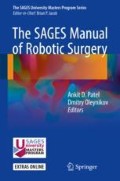Abstract
Achalasia is a rare esophageal motility disorder that is characterized by the absence of peristalsis and a defective relaxation of the lower esophageal sphincter (LES). Achalasia can be classified into primary and secondary forms. The cause of primary achalasia is unknown, but may be attributable to the loss of ganglia within the esophageal myenteric plexus. Secondary achalasia can be isolated to the esophagus or part of a generalized motility disorder affecting other portions of the GI tract. While no cure currently exists for this disease process, all present-day therapeutic approaches aim to reduce the LES pressure. Achalasia therapy can be classified into non-surgical and surgical treatments. Non-surgical treatments include pharmacotherapy using calcium channel blocker and nitrates, injection of botulinum toxin, and pneumatic dilation. Commonly used surgical treatments for achalasia are peroral endoscopic myotomy and Heller myotomy. The focus of this chapter is the surgical treatment of achalasia by Heller myotomy. Preoperative patient evaluation includes a standard dysphagia questionnaire, contrast esophagram with upper endoscopy, and manometry to confirm achalasia diagnosis. The procedure is performed using a hybrid trans-abdominal laparoscopic approach with the myotomy performed using the da Vinci Surgical System. Patients typically stay overnight and are discharged on a soft diet. Most have significant relief of dysphagia immediately, but require long-term follow-up due to the nature of their disease.
References
Hirano I. Pathophysiology of achalasia. Curr Gastroenterol Rep. 1999;1(3):198–202.
Vaezi MF, Pandolfino JE, Vela MF. ACG clinical guideline: diagnosis and management of achalasia. Am J Gastroenterol. 2013;108(8):1238–49. Quiz 1250
Pandolfino JE, Gawron AJ. Achalasia: a systematic review. JAMA. 2015;313(18):1841–52.
Sinan H, et al. Prevalence of respiratory symptoms in patients with achalasia. Dis Esophagus. 2011;24(4):224–8.
Tsuboi K, et al. Insights gained from symptom evaluation of esophageal motility disorders: a review of 4,215 patients. Digestion. 2012;85(3):236–42.
Leeuwenburgh I, et al. Long-term esophageal cancer risk in patients with primary achalasia: a prospective study. Am J Gastroenterol. 2010;105(10):2144–9.
Ravi K, Geno DM, Katzka DA. Esophageal cancer screening in achalasia: is there a consensus? Dis Esophagus. 2015;28(3):299–304.
Gelfond M, Rozen P, Gilat T. Isosorbide dinitrate and nifedipine treatment of achalasia: a clinical, manometric and radionuclide evaluation. Gastroenterology. 1982;83(5):963–9.
Ghosh B, Das SK. Botulinum toxin: a dreaded toxin for use in human being. J Indian Med Assoc. 2002;100(10):607–8, 610–2, 614.
Annese V, et al. A multicentre randomised study of intrasphincteric botulinum toxin in patients with oesophageal achalasia. GISMAD Achalasia Study Group. Gut. 2000;46(5):597–600.
Pasricha PJ, et al. Intrasphincteric botulinum toxin for the treatment of achalasia. N Engl J Med. 1995;332(12):774–8.
Torresan F, et al. Treatment of achalasia in the era of high-resolution manometry. Ann Gastroenterol. 2015;28(3):301–308.
Vaezi MF. Achalasia: diagnosis and management. Semin Gastrointest Dis. 1999;10(3):103–12.
Vaezi MF, et al. Botulinum toxin versus pneumatic dilatation in the treatment of achalasia: a randomised trial. Gut. 1999;44(2):231–9.
Inoue H, et al. Peroral endoscopic myotomy (POEM) for esophageal achalasia. Endoscopy. 2010;42(4):265–71.
Bhayani NH, et al. A comparative study on comprehensive, objective outcomes of laparoscopic Heller myotomy with per-oral endoscopic myotomy (POEM) for achalasia. Ann Surg. 2014;259(6):1098–103.
Swanstrom LL, Rieder E, Dunst CM. A stepwise approach and early clinical experience in peroral endoscopic myotomy for the treatment of achalasia and esophageal motility disorders. J Am Coll Surg. 2011;213(6):751–6.
von Renteln D, et al. Peroral endoscopic myotomy for the treatment of achalasia: a prospective single center study. Am J Gastroenterol. 2012;107(3):411–7.
Zaaijer JH. Cardiospasm in the aged. Ann Surg. 1923;77(5):615–7.
Ellis Jr FH. Oesophagomyotomy for achalasia: a 22-year experience. Br J Surg. 1993;80(7):882–5.
Bonavina L, et al. Primary treatment of esophageal achalasia. Long-term results of myotomy and Dor fundoplication. Arch Surg. 1992;127(2):222–6; discussion 227.
Richards WO, et al. Heller myotomy versus Heller myotomy with Dor fundoplication for achalasia: a prospective randomized double-blind clinical trial. Ann Surg. 2004;240(3):405–12; discussion 412–5.
Shimi S, Nathanson LK, Cuschieri A. Laparoscopic cardiomyotomy for achalasia. J R Coll Surg Edinb. 1991;36(3):152–4.
Graham AJ, et al. Laparoscopic esophageal myotomy and anterior partial fundoplication for the treatment of achalasia. Ann Thorac Surg. 1997;64(3):785–9.
Patti MG, et al. Comparison of thoracoscopic and laparoscopic Heller myotomy for achalasia. J Gastrointest Surg. 1998;2(6):561–6.
Patti MG, et al. Minimally invasive surgery for achalasia: an 8-year experience with 168 patients. Ann Surg. 1999;230(4):587–93; discussion 593–4.
Rosati R, et al. Laparoscopic approach to esophageal achalasia. Am J Surg. 1995;169(4):424–7.
Rebecchi F, et al. Randomized controlled trial of laparoscopic Heller myotomy plus Dor fundoplication versus Nissen fundoplication for achalasia: long-term results. Ann Surg. 2008;248(6):1023–30.
Horgan S, et al. Robotic-assisted Heller myotomy versus laparoscopic Heller myotomy for the treatment of esophageal achalasia: multicenter study. J Gastrointest Surg. 2005;9(8):1020–9; discussion 1029–30.
Huffmanm LC, et al. Robotic Heller myotomy: a safe operation with higher postoperative quality-of-life indices. Surgery. 2007;142(4):613–8; discussion 618–20.
Bochkarev V, Ringley CD, Oleynikov D. Robotic-assisted operative techniques in general surgery. Oper Tech Genral Surg. 2005;7:188–200.
Oleynikov D, Martin RF, editors. Surgical approaches to esophageal disease. Surg Clin North Am. 2015;95(3):i.
Author information
Authors and Affiliations
Corresponding author
Editor information
Editors and Affiliations
Rights and permissions
Copyright information
© 2018 Springer International Publishing AG
About this chapter
Cite this chapter
Chiruvella, A., Crawford, C., Krause, C., Oleynikov, D. (2018). Masters Program Foregut Pathway: Robotic Heller. In: Patel, A.D., Oleynikov, D. (eds) The SAGES Manual of Robotic Surgery. Springer, Cham. https://doi.org/10.1007/978-3-319-51362-1_4
Download citation
DOI: https://doi.org/10.1007/978-3-319-51362-1_4
Published:
Publisher Name: Springer, Cham
Print ISBN: 978-3-319-51360-7
Online ISBN: 978-3-319-51362-1
eBook Packages: MedicineMedicine (R0)

